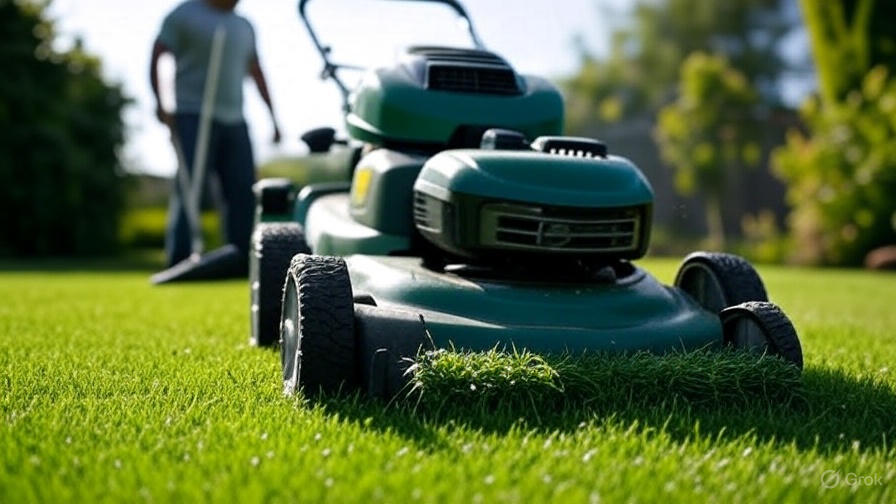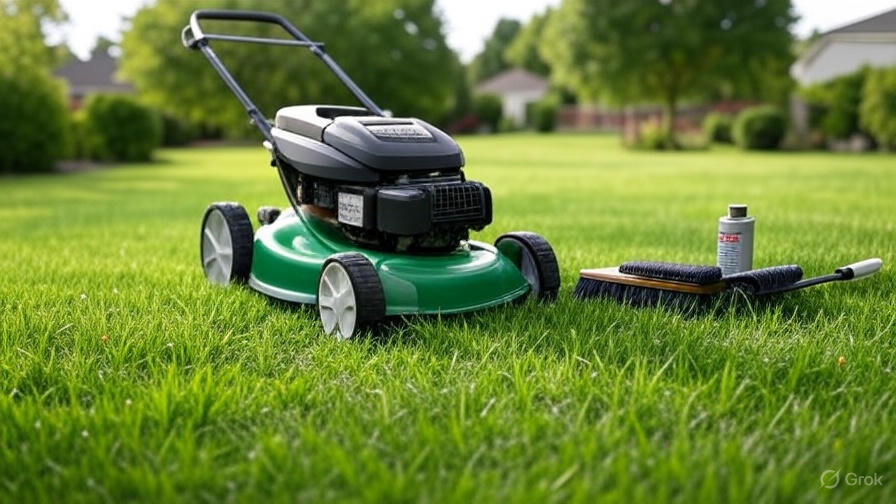How to Clean Your Lawn Mower?
Maintaining a lawn mower involves more than just keeping the blades sharp and the engine running smoothly. Regular cleaning is crucial for ensuring its longevity, optimal performance, and preventing potential mechanical issues. A clean lawn mower operates more efficiently, reduces the risk of overheating, and helps prevent the spread of lawn diseases. This comprehensive guide will walk you through the essential steps for cleaning your lawn mower, covering everything from basic debris removal to more thorough maintenance procedures.
Why Cleaning Your Lawn Mower Matters
Before diving into the cleaning process, it’s important to understand why it’s such a critical aspect of lawn mower maintenance. Here are some key reasons:
- Prevents Overheating: Accumulated grass clippings and debris can block airflow to the engine, causing it to overheat. This can lead to engine damage and reduced performance.
- Extends Engine Life: Regular cleaning helps prevent corrosion and wear on engine components, extending the lifespan of your lawn mower.
- Improves Cutting Performance: A clean mower deck allows for better airflow and more efficient grass discharge, resulting in a cleaner, more even cut.
- Reduces the Risk of Fire: Dry grass clippings near the engine or exhaust can pose a fire hazard. Cleaning eliminates this risk.
- Prevents the Spread of Lawn Diseases: Removing grass clippings helps prevent the spread of fungal diseases and pests from one area of your lawn to another.
- Easier Maintenance: A clean mower is easier to inspect and maintain. You’ll be able to identify potential problems more quickly and address them before they escalate.
Safety First: Preparing for the Cleaning Process
Safety should always be your top priority when working with any power equipment. Before you begin cleaning your lawn mower, take the following precautions:
- Disconnect the Spark Plug: This is the most important safety step. Disconnecting the spark plug prevents accidental starting of the engine while you’re working on it. Locate the spark plug wire (usually a rubber boot) and pull it firmly away from the spark plug.
- Allow the Engine to Cool: Never work on a hot engine. Allow the engine to cool completely before you start cleaning.
- Wear Safety Glasses and Gloves: Protect your eyes from flying debris and your hands from sharp edges and chemicals.
- Work in a Well-Ventilated Area: If you’re using any cleaning solvents, work in a well-ventilated area to avoid inhaling harmful fumes.
- Consult Your Owner’s Manual: Your owner’s manual contains specific safety instructions and recommendations for your particular model of lawn mower.
Tools and Materials You’ll Need
Having the right tools and materials on hand will make the cleaning process much easier and more efficient. Here’s a list of essentials:
- Scraper or Putty Knife: For removing caked-on grass clippings from the mower deck.
- Wire Brush: For scrubbing away stubborn debris.
- Garden Hose with Spray Nozzle: For rinsing away loose debris.
- Bucket of Warm, Soapy Water: For washing the exterior of the mower.
- Sponge or Cloth: For wiping down surfaces.
- Degreaser (Optional): For removing grease and oil from the engine area.
- Rust Inhibitor (Optional): For protecting the mower deck from rust.
- Air Compressor (Optional): For blowing away loose debris and drying components.
- Protective Gloves: To protect your hands.
- Safety Glasses: To protect your eyes.
- Wheel Chocks (Optional): To prevent the mower from rolling if you’re tilting it.
- Torque Wrench (If removing blades): To properly tighten blade bolts.
Step-by-Step Cleaning Guide
Now that you’ve gathered your tools and taken the necessary safety precautions, let’s move on to the cleaning process itself. Follow these steps for a thorough cleaning:
1. Remove Loose Debris
Start by removing any loose grass clippings, leaves, and other debris from the top of the mower deck and around the engine. You can use your hands (wearing gloves, of course), a brush, or an air compressor to blow away the debris.
2. Clean the Underside of the Mower Deck
This is where the majority of the grass clippings and debris accumulate. To clean the underside of the mower deck, you’ll need to tilt the mower. Important: Consult your owner’s manual for instructions on how to safely tilt your specific model of lawn mower. Typically, you’ll want to tilt it with the carburetor and air filter facing upwards to prevent fuel and oil from leaking. You can also use wheel chocks to secure the mower in place.
Once the mower is tilted, use a scraper or putty knife to remove any caked-on grass clippings from the underside of the deck. A wire brush can be helpful for scrubbing away stubborn debris. Be careful not to damage the paint or metal of the deck.
After scraping away the debris, use a garden hose with a spray nozzle to rinse the underside of the deck thoroughly. Avoid spraying water directly into the engine or electrical components.
3. Clean the Mower Blades
While you’re cleaning the underside of the mower deck, take the opportunity to inspect and clean the mower blades. If the blades are dull or damaged, now is the time to sharpen or replace them. Use a wire brush to remove any grass clippings or debris from the blades. Be careful when handling the blades, as they can be very sharp.
Note: Removing the blades for sharpening or replacement requires specific tools and knowledge. If you’re not comfortable performing this task yourself, it’s best to take your mower to a professional service center.
4. Clean the Engine Area
The engine area can accumulate dirt, oil, and grease over time. Use a degreaser and a brush to clean the engine block, cylinder head, and other engine components. Be careful not to get any degreaser on the painted surfaces of the mower.
Wipe down the engine area with a clean cloth. You can also use an air compressor to blow away any remaining debris.
5. Clean the Air Filter
A clean air filter is essential for proper engine performance. Remove the air filter cover and inspect the air filter. If the filter is dirty, clean it by tapping it gently against a hard surface to remove loose debris. You can also use compressed air to blow out the filter from the inside out.
If the air filter is excessively dirty or damaged, replace it with a new one. Consult your owner’s manual for the correct type of air filter for your mower.
6. Clean the Spark Plug
Inspect the spark plug for signs of wear or damage. If the spark plug is fouled with carbon deposits, clean it with a wire brush or a spark plug cleaner. If the spark plug is cracked or damaged, replace it with a new one.
Note: When replacing the spark plug, make sure to use the correct type of spark plug for your mower and tighten it to the proper torque specification.
7. Clean the Exterior of the Mower
Wash the exterior of the mower with a bucket of warm, soapy water and a sponge or cloth. Rinse the mower thoroughly with clean water and dry it with a clean cloth.
8. Apply Rust Inhibitor (Optional)
To protect the mower deck from rust, you can apply a rust inhibitor to the underside of the deck. Follow the manufacturer’s instructions for applying the rust inhibitor.
9. Reassemble the Mower
Once you’ve cleaned all the components of the mower, reassemble it in the reverse order of disassembly. Make sure to reconnect the spark plug wire and tighten all bolts and screws securely.
Tips for Preventing Future Buildup
Cleaning your lawn mower regularly is essential, but there are also steps you can take to minimize the buildup of grass clippings and debris in the first place:
- Mow When the Grass is Dry: Wet grass clippings tend to stick to the mower deck more easily.
- Mow Frequently: Regular mowing prevents the buildup of long grass clippings.
- Sharpen Your Blades Regularly: Sharp blades cut grass more cleanly, reducing the amount of debris that sticks to the mower deck.
- Empty the Grass Catcher Frequently: Don’t let the grass catcher overfill, as this can cause clippings to accumulate around the mower deck.
- Store Your Mower in a Dry Place: Storing your mower in a dry place helps prevent rust and corrosion.

Troubleshooting Common Cleaning Issues
Even with the best cleaning practices, you may encounter some common issues. Here’s how to address them:
- Stubborn Grass Clippings: For extremely stubborn grass clippings, try soaking the affected area with a degreaser or penetrating oil for a few minutes before scraping.
- Rust: If you notice rust on the mower deck, use a wire brush or sandpaper to remove the rust. Then, apply a rust inhibitor to protect the area from further corrosion.
- Clogged Discharge Chute: A clogged discharge chute can prevent grass clippings from being discharged properly. Use a stick or other tool to clear the blockage.
Maintaining Your Lawn Mower Beyond Cleaning
Cleaning is just one aspect of lawn mower maintenance. To keep your mower in top condition, you should also:
- Change the Oil Regularly: Follow the manufacturer’s recommendations for oil change intervals.
- Sharpen or Replace the Blades: Dull blades can tear the grass, leading to brown patches and an uneven cut.
- Check and Clean the Air Filter: A dirty air filter can restrict airflow to the engine, reducing performance and fuel efficiency.
- Inspect the Spark Plug: A worn or fouled spark plug can cause starting problems and poor engine performance.
- Lubricate Moving Parts: Lubricate the wheels, axles, and other moving parts to prevent wear and tear.
- Store the Mower Properly: Store the mower in a dry place, protected from the elements.
Conclusion
Cleaning your lawn mower is an essential part of maintaining its performance, extending its lifespan, and preventing potential problems. By following the steps outlined in this guide and adhering to safety precautions, you can keep your lawn mower in top condition and enjoy a beautifully manicured lawn for years to come. Remember to consult your owner’s manual for specific instructions and recommendations for your model of lawn mower. Regular cleaning, combined with proper maintenance, will ensure that your lawn mower remains a reliable and efficient tool for keeping your yard looking its best.







